Tungsten-Halogen Light Source

- Quartz Tungsten-Halogen Lamp with 360 - 2600 nm Output
- Stabilized Color Temperature and Output Power
- Compact Housing: 216.4 mm × 55.0 mm x 57.5 mm
- Long Lifespan: 10 000 Hours (Average)
SLS201C
Collimation Package
SLS251
Replacement Tungsten-Halogen Lamp
SLS201L
Broadband 360 - 2600 nm Source with Included SMA Fiber Patch Cable Connected to the Output

Please Wait
| Key Specificationsa | |
|---|---|
| Lamp Type | Quartz Tungsten-Halogen |
| Wavelength Range | 360 - 2600 nm |
| Color Temperature | 2796 K |
| Peak Wavelengthb | 1000 nm |
| Lamp Electrical Power | 9 W |
| Output Coupling | Fiber Coupled (SMA) and Free Space |
| Coupled Optical Power | 10 mWc |
| Included Fiber Patch Cable | M28L01 SMA-SMA, 1 m Long |
| Output Power Stabilityd | <0.05% |
| Output Power Drift per Hour | 0.01% |
| Output Power Drift per °C | 0.1% |
| Color Temperature Stability | ±15 K |
| Included Power Supply | 12 V, 100 - 240 VAC (Replacement Item # DS12) |
Accessories
- Collimation Package
- Replacement Lamp Module
- Extra Filter Holders
- Blank Insert
- Variable Attenuator Insert
Features
- Constant, Stable Intensity Output
- 0.1% per °C
- 0.01% per Hour
- Closed-Loop Control for High Stability
- Output Power Stability: <0.05%
- Color Temperature Stability: ±15 K
- 10 000 Hour Average Lamp Lifespan
- SMA Fiber Interface or Free Space Output
- Removable Filter Holder Accepts Ø1" and Ø25 mm Filters
- Compatible with 30 mm Cage System
- Low-Noise Fan Cooling
Thorlabs' SLS201L(/M) Stabilized Tungsten-Halogen Light Source provides a constant-intensity blackbody radiation spectrum from 360 to 2600 nm. An internal feedback system is employed to achieve a highly stable power output. The superior performance of Thorlabs' stabilized light sources makes them ideal for experiments that require high accuracy and stability, such as transmittance and reflectance measurements.
The SLS201L(/M) light source features an integrated filter holder and offers a fiber-coupled output with an SMA connector. The fiber coupling package can be replaced with a collimation package (sold separately) for free-space applications. The quick-release mechanism used to mount the fiber coupling package ensures coupling efficiency is maintained when replacing the fiber coupling package. Internally-threaded lens tubes can also be attached directly to the front of each light source using the SM1QAM Quick-Release Adapter for custom optical systems. The compact housing (see Specs tab) gives the user flexibility with positioning this light source on a crowded optical table. The light source can be post mounted by using the two 1/4"-20 (M6) taps on the bottom of the device and our Ø1" posts.
The front face features four 4-40 taps (as shown in the left image below) for Ø6 mm cage rods, making this device compatible with Thorlabs' 30 mm cage system. The back face has an on/off toggle switch, power indicator LED, and power connection (see image to the bottom right). A filter holder is included with each light source. This filter holder can accommodate Ø1" and Ø25 mm optics up to 0.31" (8.0 mm) thick, allowing bandpass filters to be placed in the light path for applications requiring constant-intensity illumination at a specific wavelength. Alternatively, a sample can be installed in the filter holder between two glass plates, allowing this light source to be used for material analysis. An included SM1RR retaining ring is used to secure the optic inside the holder. We recommend the SPW602 spanner wrench to secure the retaining ring without damaging the optic. The filter holder can be locked into place using the included hex key and a setscrew located on the side of the device (see the center image below). The light sources are also compatible with the CFH2-F filter holder (sold separately below), enabling the user to quickly change between different filters or samples. Additionally, the CFH2-V Variable Attenuator Insert can be used in place of the filter holder to partially or completely block light from passing through the aperture.
Replacement lamp modules are available; refer to the Lamp Replacement tab for detailed instructions. Be sure to purchase the appropriate collimation package and lamp module for the light source, as they are not interchangeable. If a higher color temperature is desired, our color-balancing filters can be used to attenuate red light from the light sources while passing blue light. This results in a beam with a higher color temperature and lower total power.
The removable filter holder (filters sold separately) allows the user to mount Ø25 mm or Ø1" optics inside the stabilized light source. The front face of the light source features four 4-40 tapped holes, making it compatible with our 30 mm cage system.
The filter holder can be locked into place with the filter setscrew located on the side of the housing. The fiber coupling package can be quickly removed and replaced with a collimation package.
The on/off switch, power indicator, and power input are located on the back of each light source.
| Item # | SLS201L(/M) |
|---|---|
| Lamp Type | Quartz Tungsten-Halogen |
| Wavelength Range | 360 - 2600 nm |
| Color Temperature | 2796 K |
| Peak Wavelengtha | 1000 nm |
| Bulb Electrical Power | 9 W |
| Output Coupling | Fiber Coupled (SMA) and Free Space |
| Fiber-Coupled Optical Power | 10 mWb |
| Free-Space Optical Power | 500 mWc |
| Collimated Optical Powerd | 60 mW |
| Included Fiber Patch Cable | M28L01 SMA-SMA Cable, 1 m Long |
| Beam Divergence without Fiber Couplere | 8.2° |
| Beam Divergence with Optional Collimatore | 2° |
| Beam Diameter with Optional Collimatorf | 24 mm |
| Output Power Stabilityg | <0.05% |
| Optical Power Drift per Hour | 0.01% (Typical) |
| Optical Power Drift per °C | 0.1% (Typical) |
| Color Temperature Stability | ±15 K |
| Lifespan | 10 000 Hours (Avg.) |
| Compatible Filter Size | Ø1" and Ø25 mm Up to 0.31" (8.0 mm) Thick |
| Operating Temperature | 0 °C to 45 °C |
| Storage Temperature | -15 °C to 70 °C |
| Included Power Supply | 12 V, 100 - 240 VAC (Replacement Item # DS12) |
| Dimensions (L × W × H) | 216.4 mm × 55.0 mm x 57.5 mm (8.52" × 2.17" x 2.26") |
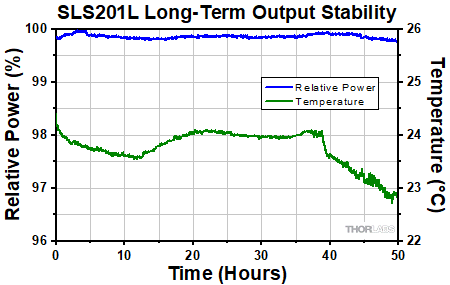
Click to Enlarge
The power output and temperature of an SLS201L light source were measured over 50 hours of continuous operation. The source was run for 30 minutes to warm up and stabilize before this data was taken.
SLS201L(/M) Stabilized Light Source Power Connector
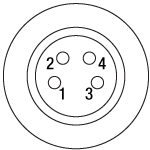
| Pin | Description |
|---|---|
| 1 | No Connection |
| 2 | No Connection |
| 3 | +12 VDC |
| 4 | Ground |
The installation instructions and animation below detail the recommended procedure for replacing the lamp module in the SLS201L(/M) Stabilized Light Source. Be sure to install the correct lamp module in its corresponding light source, as the they are not interchangeable.
We strongly recommend wearing gloves when replacing the lamp to prevent skin oils from being deposited onto the lamp. If you suspect the lamp is dirty, carefully clean it with alcohol before connecting it to a power supply.
Lamp Replacement Procedure
Open the Cavity
- Using a 2 mm hex key, remove the screw closest to the end of the unit on the left and right sides. Do not remove the screws closest to the fan ventilation holes.
- Using the same 2 mm hex key, remove the four screws securing the cavity cover, located on the underside of the unit.
Remove the Old Lamp
- Unplug the white plug that is connected to the lamp module. This plug is located on the far side of the circuit board if the output aperture of the lamp is facing to the right.
- Using the 1.5 mm ball-end hex key included with each replacement lamp, remove the cap screw located about half way down on the aluminum divider that separates the PCB chamber and the lamp chamber.
- Remove the old lamp by sliding the wire and attached plug out through the hole in the aluminum divider.
Note: Two aluminum dowel pins, located on either side of the lamp module, may slip out of their holes while the lamp is being removed. Be careful not to misplace them as they are needed for the new lamp installation.
Install the New Lamp
- Place the two dowel pins in their corresponding holes in the new lamp module.
- Slide the new lamp module in the lamp chamber, point up. Pass the wire and plug through the hole in the divider first and then insert the module. The two dowel pins should slide smoothly into the holes in the divider.
- While pressing the lamp against the divider, screw the cap screw back in using the included 1.5 mm ball-end hex key.
- Insert the white plug back into the circuit board and secure the cavity cover.
Reflection Spectroscopy Application
These broadband light sources can be used along with our reflection spectroscopy probes, CCD spectrometers, and fiber probe holders to take diffuse reflection, specular reflection, and color measurements.
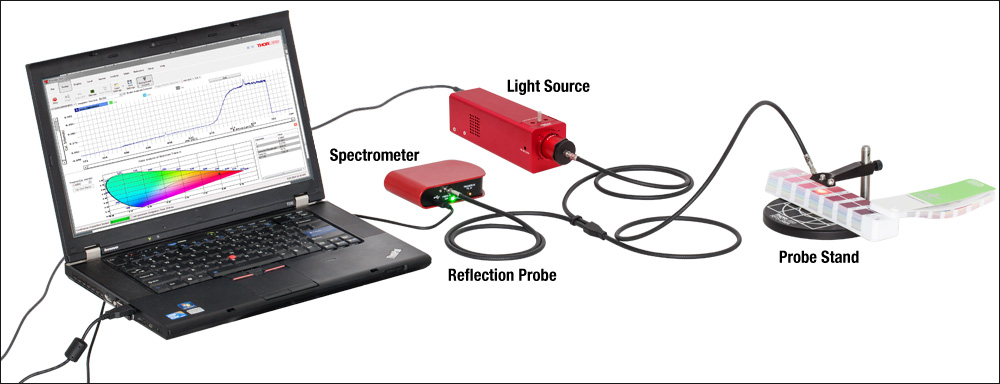
Spectrometers
Thorlabs offers several CCD-based spectrometers for use in the visible, NIR, or UV to NIR spectral ranges. The CCS100 and CCS175 operate in the 350 - 700 nm and 500 - 1000 nm spectral ranges with 0.5 nm and 0.6 nm resolution, respectively. The extended-range CCS200 operates in the 200 - 1000 nm spectral range with 2.0 nm resolution, but the UV range may be heavily attenuated when analyzing broadband spectra.
Light Sources
The SLS201L tungsten-halogen broadband fiber-coupled light source, sold below, delivers a 2796 K blackbody-type spectrum in the 360 - 2600 nm wavelength range and has active electronic stabilization for low spectral and intensity drift. Alternatively, the SLS203F(/M) Globar light source provides fiber-coupled output with a 1500 K temperature and 500 - 9000 nm emission range. We also offer fiber-coupled LEDs available with a selection of peak wavelengths or a broadband white-light emission spectraand our line of fiber-coupled laser sources offers a selection of options for intense single-wavelength illumination.
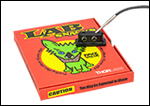
Click to Enlarge
Diffuse Measurement Taken at 45° Using RPH Holder Block
Reflection Probe Fiber Bundles
Thorlabs offers reflection probes with either high-OH or low-OH multimode fiber for wavelengths from 250 - 1200 nm and 400 - 2400 nm, respectively. Probes are available with a sample end that terminates in either a Ø1/4" probe or an SMA905 connector. We also offer Ø1/4" and SMA-terminated probes with linear fiber bundle spectrometer ends for increased spectrometer coupling efficiency for samples with low reflectance.
If the coaxial illumination provided by a reflection probe bundle is not critical, separate fiber patch cables or bundles with SMA connectors can be used for illumination and signal collection. Our large-core round bundles maximize illumination intensity, while our single-fiber multimode SMA patch cables are useful for precise illumination, or for connection to a fiber-coupled laser. We also offer round-to-linear fiber bundles, which maximize signal strength at the spectrometer.
Reflection Probe Holders
Thorlabs offers the RPS and RPS-SMA fiber probe stands (RPS-SMA shown above and to the right), which allow for precise, stable positioning of the fiber optic probe at an angle of 90° or 45° relative to the sample. The probe holder arms (also sold separately) can also be integrated into other optomechanical setups using Ø1/2" posts. Alternatively, the RPH and RPH-SMA probe holder blocks sit directly on a sample, allowing the fiber tip to be positioned close to the surface and also blocking out room lights from the area under test.
| Posted Comments: | |
Lara Piemontese
(posted 2024-06-04 10:43:12.5) Good morning, I have recently started to work with the broadband light source SLS201L/M with free space collimator SLS201C. For power reason, namely I need to work with the maximum power achievable, I'm using the free space collimator instead of the fiber coupling. Moreover, I have a bandpass filter in the holder placed inside the lamp, but the problem I'm going to report here doesn't depend on the presence of the bandpass filter. I'm currently facing the problem of focusing the output beam (which is approximately 2.4 cm) into a very small beam of 400 um. I use a doublet of lenses but I cannot focus the spot into something smaller than 2 mm, regardless of the ratio of the focal lengths of the two lenses. This happens with every doublet that I choose. May I ask you what do you think is the problem in focusing this source and what do you suggest in order to solve it (for example the use of special lenses or alternative collimators)? Thank you cdolbashian
(posted 2024-06-18 09:30:56.0) Thank you for contacting Thorlabs. The SLS201L/M is a broadband light source and has a very large divergence angle even after collimation. In the process of focusing the spot, the divergence increases significantly as the beam size decreases, resulting in difficulty to get such a small focused spot. We will contact you directly to discuss your application in detail. 諒一 芝山
(posted 2024-04-04 08:42:21.873) 同製品を使用させて頂いております。
光源本体の発光面サイズをご提示いただくことは可能でしょうか? cdolbashian
(posted 2024-04-26 08:56:09.0) Thank you for your inquiry. You have asked the following question: "We are using the following product. Is it possible for you to provide the size of the light emitting surface of the light source itself?" The tungsten filament size within the SLS202L is approximately 1.6 mm in length and 2 mm in diameter. This is a rough number and we currently do not have data on exact tolerance. Johan Leijtens
(posted 2024-03-25 14:17:51.87) what is the core diameter of the patch cable? cdolbashian
(posted 2024-03-29 12:08:57.0) Thanks for contacting Thorlabs! The core diameter of the patch cable included in SLS201L is 400μm. Alexander Novikov
(posted 2024-01-18 19:36:45.637) Hi. Is it possible to change the CaF2 lens inside the SLS203L(/M) from uncoated to coated to increase performance? Thank you. jdelia
(posted 2024-01-25 01:02:52.0) Thank you for contacting Thorlabs. The internal CaF2 lens of SLS203L(/M) is LA5370. Replacing a lens with an AR coated lens will increase transmission performance within the spectral range for which the coatings are designed. The performance outside of the coating spectral range, however, is not predictable and varies from batch to batch. For example, if you are using LA5370-E with an AR Coating from 2 to 5 µm, we only guarantee the transmission will be increased from 2 to 5 µm. Ruihang Dai
(posted 2023-12-04 14:39:34.35) Hello,
I'm Ruihang Dai from the Technical University of Munich, we want to get some information about the light source SLS 201/202/203 L, we would like to use it to calibrate our camera system.
the initial situation is, that we need a standard light source which can provide us accurate spectral radiance (w/nm sr), and the best irradiance(w/nm m^2 sr) to find out the mapping between the digital value and physical radiation in our multi-spectral camera.
the standard light source provided by Thorlabs has an excellent performance, and here I have additional 3 questions:
1. the data given by the light is the spectral radiance (w/nm sr), is there any possibility or other solution to obtain the spectral irradiance(w/nm m^2 sr)? or how good is the uniformity of the light? if is good, we can also calculate by our self
2. how strong is the light? the intensity is also important for us, if the light is weak the influence of the environment must be considered, which is not good for us.
3. is there any solution or other comparable devices that provide a sphere light source instead of fiber light source?
thanks for your support! if you have any questions please let me know.
kind regards,
Ruihang Dai cdolbashian
(posted 2023-12-15 04:22:07.0) Thanks for contacting Thorlabs! To answer each question directly: 1. The SLS201/202/203L are stabilized light sources for applications where the absolute spectrum or radiance is not that important. We don't measure the spectral radiance or irradiance for each unit. This is mainly due to the reason that the spectral radiance tends to decrease with an increased duration of usage, and the spectral radiance distribution is not uniform. 2. The output power parameters under different coupling methods can be found in the "Specs" tab. For example, the fiber-coupled, collimated, and free-space optical power for the SLS201L(/M) at the beginning of the bulb lifetime are 10mW, 60mW, and 500 mW respectively. 3. We will reach out to you directly regarding your request. Burak Özer
(posted 2023-11-09 11:37:19.727) Dear Thorlabs team, I am using SLS203L to measure the sensitivity of my spectrometer in the wavelength range of 2-6 micrometers. The spectral power distribution of SLS203L is provided up to 5.5 micrometers on the website. I would like to know if you have the data between 5.5-6.0 micrometers. Leh Woon Lim
(posted 2023-08-25 11:54:45.797) Hi,
I recently purchased this light source and was keen to use it for infrared sensing experiments. However, I am having a hard time collecting the light and reducing the beam size in my setup (I am relying on the visible spectrum for this currently). I am wondering if the light exiting the light source is "collimated" and if there was any way I could adjust the position of the LA5370 collimating lens inside the light source.
Cheers,
Leh Woon cdolbashian
(posted 2023-08-30 10:38:16.0) Thanks for contacting Thorlabs! The light output from the bulb is collimated by a lens. Due to the large emitter size and the broad wavelength range, the divergent angle after collimation will still be relatively large. The position of the collimation lens is already optimized so we recommend not to adjust its position. We will contact you directly to discuss your application in more detail. user
(posted 2022-12-06 10:31:51.93) Dear Sir or Madam,
could you please recommend me proper safety goggles for the use of SLS203L/M. Due to the wide wavelength range I have no idea, which is the best solution.
Kind regards cdolbashian
(posted 2022-12-15 02:52:27.0) Thank you for contacting Thorlabs. LG11 offers the best coverage for the wavelengths used in this light source. Chaman Gupta
(posted 2022-06-17 12:11:29.753) Is the SLS201L NIST calibrated? If not, is there any other lamp that is NIST calibrated? cdolbashian
(posted 2022-06-21 08:42:57.0) Thank you for reaching out to us with this inquiry Chaman. These SLS* lamps are not NIST calibrated. I will contact you to discuss other options. user
(posted 2022-06-07 15:23:14.99) Hi, I am using a SLS203L lamp; my question is in the specs a 0.03% optical power drop per hour is given: is this drop occurring in spite of the internal feedback stabilization (without stabilization it would be even higher)?
Also, if the lamp operates in a hot environment (warmer than lab conditions, say 30-35°C) what do I expect as a response, should the lamp decrease or increase its power output? Can a large external fan help in cooling it down a bit? cdolbashian
(posted 2022-06-17 04:46:39.0) Thank you for contacting Thorlabs. There is a built-in closed-loop feedback in SLS203L to stabilize the intensity of the bulb. "0.03% per Hour" means a maximum increase/decrease of 0.03% over a stable baseline. The stability spec is only valid after the light source reaches a thermal equilibrium. 30-35°C is within the operating temperature range of the SLS203L. Between power cycles or when there is a temperature change in environment, the light source may drift and stabilize on a different equilibrium, causing a change in the mean power output. To minimize the power drift, thermal equilibrium and thermal management are required. Shree Krishnamoorthy
(posted 2021-09-20 12:22:26.143) Dear Thorlabs team,
I am interested in 2-2.5 um band. I wanted to know which of the 201/202 and 203 had the most power on that band. Also, if it was 203, could I fiber couple the same?
Thanks
Shree YLohia
(posted 2021-10-11 02:51:08.0) Hello Shree, thank you for contacting Thorlabs. The SLS202L is recommended for this wavelength range when coupling into a fiber. This source is specifically designed to work with the MZ41L1 ZrF4 MIR Patch Cable. The SLS203L has a fairly large emitter size and, thus, is not suitable for fiber coupling applications. Yohei Nagai
(posted 2021-07-16 14:19:23.17) Lifespanに関して質問があります。
Lifespanが10000H(Average)と記載されていますが、10000H後の特性が知りたいです。
連続使用の場合、光源の初期強度を100%としたときに光源強度が90%まで劣化するまで何時間くらい掛かりますか?
I have a question about Lifespan.
Lifespan is described as 10000H (Average), but I would like to know the characteristics after 10000H.
In the case of continuous use, how long does it take for the light source intensity to deteriorate to 90% when the initial intensity of the light source is 100%? YLohia
(posted 2021-07-21 03:31:42.0) Thank you for contacting Thorlabs. When the bulb is close to its end of life, the color temperature will be significantly lower (and thus, the spectrum will also be quite different). Unfortunately, we currently do not have sufficient data to empirically specify the end of life characteristics. A very rough estimation for a 10% intensity drop from its initial power is around 2000 to 3000 hours. Guillermo Salceda Delgado
(posted 2019-08-08 11:40:18.83) It is just a question,
Is it possible to couple the light from this white source to a single mode fiber instead of multimode fiber? YLohia
(posted 2019-08-08 01:57:05.0) Hello, thank you for contacting Thorlabs. Unfortunately, since this cannot be considered a point source (and is highly divergent), the coupling efficiency into a few um core size single mode fiber is going to be very low (< 1%). user
(posted 2019-03-26 12:59:16.753) Hi, What a pinhole size is used in the SLS201C collimation package? Thanks. YLohia
(posted 2019-03-26 02:59:28.0) Hello, the pinhole diameter used is 1mm. abc124771
(posted 2019-02-03 22:21:34.577) Can you please tell the specs of the collimating lens that's inside the light source main body of SLS202L/M? nbayconich
(posted 2019-02-06 11:20:07.0) Thank you for contacting Thorlabs. The collimating lens in SLS202L/M is a calcium flouride lens, part number LA5370 while the focusing lens is LB5774. I will reach out to you directly. abc124771
(posted 2018-12-03 09:01:14.84) Could you please tell the coherence length of SLS202L/M and also how I could calculate it myself? YLohia
(posted 2018-12-03 12:47:57.0) Hello, thank you for contacting Thorlabs. The SLS202L is an incoherent source so there is no coherence length and, thus, cannot be calculated. iu
(posted 2018-09-20 10:40:52.67) Hello,
Can you please tell me which one from these sources has maximum output power in the range from 1 µm up to 2 µm?
(Comparison between all 3 sources using the same outcoupling: lenses, filters, fibers, etc.) YLohia
(posted 2018-09-20 10:10:43.0) Hello, thank you for contacting Thorlabs. This can be found by using the raw data supplied in the "Graphs" tab and finding the area under the curve after undoing the normalization using the specified total power output from the bulb. For the 1-2um region, the SLS203L will produce the most power, followed by the SLS201L producing slightly more than half of that. jeremie.dain
(posted 2017-08-19 06:48:52.9) Hi, Can you check the coupled power with M96L and M15L fibers? tfrisch
(posted 2017-08-28 11:19:08.0) Hello, thank you for contacting Thorlabs. A very rough estimate would equate the power ratio to the core area ratio which would yield under 1mW coupling efficiency. I will reach out to you directly about how to better estimate the coupled power. guillaume.paradis
(posted 2017-08-11 14:21:35.75) Would it be possible to get a power spectral density for this product? (dBm/nm). Also is it possible to get other kind of fiber adapter (FC for example) tfrisch
(posted 2017-08-16 06:40:11.0) Hello, thank you for contacting Thorlabs. The reason we use arbitrary units for the power is because it will depend on the core size of the fiber used or whether it is coupled to freespace. We list the raw data normalized, so to convert, you would just multiply every cell by the total power you measure through your fiber in mW and divide by the sum of the column with normalized units. You could then convert that to dBm. As for adapting to an FC fiber, the S120-SMA adapter can be unscrewed and replaced with S120-FC or another fiber adapter with internal SM1 threads. I will reach out to you directly to discuss this as well. p.blasco
(posted 2017-02-07 04:51:45.357) I have the SLS203 source. Since the source is until 9000 nm, does it is possible to have the measured spectrum until this wl? tcampbell
(posted 2017-02-07 09:32:48.0) Response from Tim at Thorlabs: the detector used to measure the spectral power data is only optimized for wavelengths up to 5500 nm. However, the SLS203L will behave similarly to a black body at 1500 K for wavelengths up to 9000 nm. The 1500 K black body spectral data is available by clicking the Raw Data link underneath the SLS203L Spectral Power Distribution plot in the Graphs tab. samzlemieux
(posted 2016-09-27 16:18:41.753) I have an SLS201. I wanted to download the spectral power distribution from the Thorlabs website, but the product was discontinued. Can you send me the spectral power distribution of the SLS201? jlow
(posted 2016-09-29 11:36:37.0) Response from Jeremy at Thorlabs: The SLS201 and SLS201L uses the same bulb and optic so you can use the spectral power distribution data for the SLS201L on the website. tfrisch
(posted 2016-08-25 09:02:34.573) Hello lleclair, thank you for contacting Thorlabs. The spectrum listed is for the bulb and a collimating lens necessary to use our Optical Spectrum Analyzer. I have contacted you with more details. -Tyler at Thorlabs USA lleclair
(posted 2016-08-02 14:53:16.08) The emission spectrum shown can't be correct for a quartz halogen lamp, H2O and CO2 alone in the air cannot account for the apparent spectral features.
I think the emission spectrum shown must be after light has traveled though the fiber optic.
Can you please provide an emission spectrum for the SLS201L that shows the output of the source only, without any attachments, fiber optics or collimator? jonathan.rasson
(posted 2015-12-17 22:43:38.42) Hello, like hyunhuh I'm interest in data concerning the power density depending on the wavelength. Would it be possible to obtain any information about this? besembeson
(posted 2015-12-21 06:33:43.0) Response from Bweh at Thorlabs USA: We don't currently have this data, but we are working on this and will publish on the website once we complete the measurements. hyunhuh
(posted 2015-11-09 15:22:02.347) I wonder if you could get a graph, spectral power density (mW/nm) vs wavelength. smcelwee
(posted 2015-11-16 11:25:34.0) Response from Sean M at Thorlabs USA: Thank you for your inquiry. I'm currently looking into your request and will contact your directly to discuss this further. cristina.roisorza
(posted 2015-09-25 12:38:45.94) Hello. I contact again because we have not had any answer yet.
we really need a broadband source for measuring fiber optic devices with an OSA (1200 - 1700 nm).
Could you tell the energy level for the SLS201 if we work with a single mode fiber (G652D).
Thank you very much
CRO cristina.roisorza
(posted 2015-09-11 14:31:32.833) Hello. I need a broadband source for measuring fiber optic devices with an OSA (1200 - 1700 nm). The SLS201 is very promising, but could you tell the energy level for the mentioned interval if we use a single mode fiber (G652D).
Thank you
CRO besembeson
(posted 2015-09-28 01:54:28.0) Response from Bweh at Thorlabs USA: The SLS201 was designed for use with our OSA200 series with free space and multimode fiber coupling. In general, I expect that you would have very low coupling efficiency to a single mode fiber with a broadband source such as the SLS201 which may not be suitable for your OSA. We plan on doing some tests with our OSAs from SLS201 source coupled to a single mode fiber and I will follow-up with you once we have the data. For now, I would recommend our broadband SLDs if the wavelength span is enough for your application: http://www.thorlabs.hk/newgrouppage9.cfm?objectgroup_id=1760 malleblas
(posted 2015-08-11 00:12:41.99) I am wondering if it is possible to vary the lamp temperature. I want to use this for a quick cross check verification of radiation thermometers in-situ against a calibrated reference radiation thermometer. jlow
(posted 2015-08-25 03:22:35.0) Response from Jeremy at Thorlabs: Unfortunately the lamp temperature cannot be changed. jma215
(posted 2015-06-02 11:53:06.63) I am interested in the SLS201 with collimation package, and in my set up would need to narrow the beam to a diameter of about 2mm. What would you recommend to do this, while minimizing beam divergence? besembeson
(posted 2015-08-28 12:24:34.0) Response from Bweh at Thorlabs USA: After you collimate the beam using the SLSC1, you can use a beam expander in reverse to make diameter smaller but note that your divergence will be increased by same reduction factor. Our UK division will followup with you. cbrideau
(posted 2014-12-02 20:36:07.73) We had be struggling for months to find a good calibration standard for the imaging spectrometer on our Nikon A1 microscope. We just got the SLS201 and it seems to be working out fairly well. We did find the fiber coupled source a bit difficult to use with the imaging system in the microscope (loss from fiber and difficulty coupling light into microscope objective lowered signal too much) so I ended up with a direct-coupled system instead of the fiber. This worked well and gave ample signal. cdaly
(posted 2014-12-04 02:54:28.0) Response from Chris at Thorlabs: Thank you for your feedback. If you run into anything else, please do not hesitate to contact us at techsupport@thorlabs.com steve
(posted 2014-11-17 08:58:25.92) is SLS201 shot noise limited ? jlow
(posted 2014-11-25 11:17:46.0) Response from Jeremy at Thorlabs: The output of the SLS is monitored by a regular photodiode and the light source is stabilized according to the feedback from the photodiode. Since the the photodiode is not temperature controlled and it is operating near room temperature, the SLS series would not be shot noise limited. yagor
(posted 2014-10-21 09:07:11.443) Is it possible to purchase SLS201, and use SLS252 for making it SLS202 when needed? jlow
(posted 2014-10-22 02:06:14.0) Response from Jeremy at Thorlabs: The bulbs are not interchangeable and you cannot install the SLS252 in the SLS201. peh
(posted 2014-08-08 11:33:49.46) I am very interested in the SLS201 light source.
I just want to know if it is possible to change the spectral output of the SLS201 by setting jumpers on the electrical drive board. In others words is it possible to change the lamp temperature? jlow
(posted 2014-08-11 08:57:12.0) Response from Jeremy at Thorlabs: It's not possible to change the lamp temperature. The only way we recommend to change the spectral output would be to put filters in front. laurent.remy
(posted 2014-06-25 09:13:12.43) Hi, Can you please give me the same information as "juliusmadrid" about the coupled power with a SMF28e+ fiber ? pbui
(posted 2014-06-27 09:45:54.0) We will contact you to provide the experimental data. juliusmadrid
(posted 2014-05-28 03:39:51.627) Hi,
Can you check the coupled power with a SM28e+ fiber?
or with Nufern S405-XP? Theoretical calculation is fine. pbui
(posted 2014-06-02 02:31:36.0) We will contact you to provide the experimental data. f95941056
(posted 2013-10-31 13:56:29.06) Can you provide the typical output spectrum of SLS201 in dBm/nm scale with 50/125 MMF or SMF28e as the output fiber, so that we can compare with products from other vendors? Can users replace the bulb own their own? jlow
(posted 2013-11-07 04:23:24.0) Response from Jeremy at Thorlabs: We have not measured the output of the SLS201 with 50µm MM fiber and SMF28e+ fiber before. We will look into measuring this and will contact you directly about this. thomas.ellis
(posted 2013-08-03 15:49:05.13) I have the sls201 lamp source. I am using it with some 10nm filters and it is nice that those filters come with an excel file of the spectral bandpass. It would be nice if this lamp had a similar excel file. As it is I copied the displayed plot and digitized it by hand. jlow
(posted 2013-08-07 14:44:00.0) Response from Jeremy at Thorlabs: We will contact you directly to provide the Excel file. |
Below is a selection guide for all of our white-light, broadband, lamp-based light sources. In addition to these sources, Thorlabs also offers unmounted white-light LEDs, white-light mounted LEDs, white-light fiber-coupled LEDs, and high-powered, white-light Solis® LEDs.
| Broadband Light Source Selection Guide | ||||||||||
|---|---|---|---|---|---|---|---|---|---|---|
| Item # | (Click to Enlarge; Not to Scale) |
Emitter Type | Wavelength Range (Click for Plot) |
Output Coupling | Output Power | Lamp Electrical Power |
Color Temperature |
Lamp Lifetime |
Replacement Lamp |
|
| SLS204 | Deuterium | 200 - 700 nm | Free Space or Fiber Coupled (SMA) |
2 mWa 0.1 mWb (Typ.) |
30 W | N/A | 2000 hc | SLS254B | ||
| SLS205 | Xenon Arc | 240 - 1200 nm | Free Space or Fiber Coupled (SMA) |
290 mWa 5 mWd (Typ.) |
75 W | 5800 Ka 5400 Kd |
2000 hc | SLS255B | ||
| SLS401 | Xenon Arc | 240 - 2400 nm | Free Spacee | >1.3 Wa | 150 W | 5800 K | 2000 hc | SLS401Bf or SLS402B |
||
| SLS402 | Mercury-Xenon Arc | 240 - 2400 nm | Free Spacee | >1.3 Wa | 150 W | 6000 K | 2000 hc | SLS401B or SLS402Bf |
||
| SLS302 | Quartz Tungsten-Halogen |
360 - 2500 nm | Free Spacee | >10 Wa | 150 W | 3400 K | 1000 hg | SLS301B | ||
| SLS201L(/M) | Quartz Tungsten-Halogen |
360 - 2600 nm | Free Spacee or Fiber Coupled (SMA) |
500 mWa 10 mWh |
9 W | 2796 K | 10 000 h | SLS251 | ||
| SLS301 | Quartz Tungsten-Halogen |
360 - 3800 nm | Free Spacee | >1.6 Wa | 150 W | 3400 K | 1000 hg | SLS301B | ||
| SLS603 | Xenon Arc | 380 - 780 nm | Ø3 mm Liquid Light Guide |
>7 Wh | 300 W | 6000 Ki | 1000 hc | SLS600B | ||
| SLS605 | Xenon Arc | 380 - 780 nm | Ø5 mm Liquid Light Guide |
>15 Wh | 300 W | 6000 Ki | 1000 hc | SLS600B | ||
| OSL2 | Tungsten-Halogen | 400 - 1600 nm (Typical) |
Fiber Bundle | 1.4 Wk | 150 W | 3200 K | 1000 hc | OSL2Bf, OSL2B2, or OSL2BIR |
||
| OSL2IR | Tungsten-Halogen | 400 - 1750 nm (Typical) |
Fiber Bundle | 3.8 Wk | 150 W | 3200 K | 200 hc | OSL2B, OSL2B2, or OSL2BIRf |
||
| QTH10(/M) | Quartz Tungsten-Halogen |
400 - 2200 nm | Free Space | 50 mW (Typ.) | 10 W | 2800 Kl (Typ.) | 2000 h | QTH10B | ||
| SLS203F(/M) | Silicon Carbide Globar | 500 nm - 9 µm | Free Spacee or Fiber Coupled (SMA) |
1.8 Wa | 24 W | 1500 K | 10 000 h | SLS253 | ||
| SLS303 | Silicon Nitride Globar | 550 nm - 15 µm | Free Space | 4.5 Wa | 70 W | 1200 K | 5000 hg | SLS303B | ||


Click to Enlarge
The SLS201L(/M) contains an N-BK7 LBF254-040 Spherical Lens and a B270 ACL2520U Aspheric Lens to couple blackbody radiation into a fiber.
- 360 - 2600 nm Stabilized Light Source
- Includes Fiber Patch Cable and DS12 Power Supply
- >10 mW Coupled Power Through Included M28L01 Patch Cable
- Replacement Lamp Module Sold Below
Thorlabs' Stabilized Tungsten-Halogen Light Source provides a constant-intensity, 10 mW blackbody radiation spectrum between 360 and 2600 nm. Since the blackbody spectrum spans both the visible and near-infrared spectral ranges, this source is ideal for integration into optical measurement equipment. Combine the stabilized light source with a reflection probe and spectrometer for diffuse reflection and fluorescence measurements or use it to back-illuminate a test target as part of a detector calibration system. It can also be used as an illumination source in a white light interferometer for applications such as mapping surface structure. The included filter holder is interchangeable with the CFH2-F filter holder, sold below.
The coupled output power of the SLS201L(/M) source with the included multimode M28L01 SMA-SMA fiber patch cable is 10 mW. Patch cables with smaller core sizes and numerical apertures or longer fibers can be used at the expense of the output power while a larger core size or shorter fiber length can increase the output power. The S120-SMA fiber adapter on the front of this light source is removable and can be replaced with any internally SM1-threaded fiber adapter. In particular, to provide compatibility with LLGs, the SM1T1 coupler can be used with a liquid light guide (LLG) collimation adapter. Transmission of wavelengths longer than 800 nm through the LLG for longer than an hour may result in permanent damage to the LLG tip; to reduce damage during extended use, incorporate a filter to limit transmission of IR wavelengths.
Take care when removing and reinserting the fiber adapter, as it is pre-adjusted to its optimum position during manufacturing. The adapter may be loosened and adjusted using the included 30 mm hex wrench. Alternatively, the entire fiber coupling package can be replaced by the SLS201C Collimation Package (sold below) to allow this light source to be used in free-space applications.
An internal fan keeps the light source temperature regulated. This fan is low noise and engages only when the internal temperature exceeds 65 °C. The SLS201L(/M) includes a DS12 power supply.

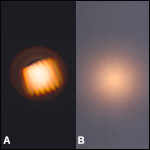
Click for Details
SLS201L Beam Profile with
(A) SLS201C Collimator Only,
(B) SLS201C and DG10-600-MD Diffuser
- SLS201C Collimation Package for SLS201L(/M) Stabilized Tungsten-Halogen Light Source
- SLSC1 Collimation Package for Previous-Generation SLS201(/M) Source
The SLS201C collimation package for the SLS201L(/M) tungsten-halogen stabilized light source consists of two uncoated aspheric condenser lenses and a pinhole packaged inside an internally SM1-threaded (1.035"-40) quick-release lens tube, which is engraved with the item number for easy identification.
We also offer the SLSC1 collimation package for our previous-generation SLS201(/M) sources, respectively. The SLSC1 collimator is not compatible with the SLS201L(/M) light source sold above.
To install, unthread the fiber adapter from the output of the light source and thread on the appropriate collimation package. Be sure to install the correct collimation package in its corresponding lamp, as they are not interchangeable.
Please note that the output beam cannot be perfectly collimated due to the halogen lamp's incoherent emission. The collimation package may be used directly with its compatible light source (see A in photo to the right, 25 cm away from the end of the collimation package), or it may be used in conjunction with a Ø1" mounted diffuser attached to the threaded end of the collimation package (see B in photo above). The diffuser serves to smooth out the beam profile while increasing the beam divergence angle.

- Replacement Tungsten-Halogen Lamp for SLS201L(/M) Stabilized Light Source
- Electrical Power: 9 W
- Color Temperature: 2796 K
The SLS251 lamp module is a replacement for the SLS201L(/M) tungsten-halogen stabilized light source. Please see the Lamp Replacement tab for detailed instructions. Each module comes with the required 1.5 mm balldriver / hex key. Be sure to install the correct module in its corresponding light source, as modules are not interchangeable.
Note: We strongly recommend wearing gloves when replacing the lamp module in any of our stabilized light sources to prevent skin oils from being deposited onto the lamp. If you suspect the lamp is dirty, carefully clean it with alcohol before connecting it to a power supply.

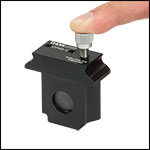
Click to Enlarge
Pushing the adjuster down on the CFH2-V quickly closes the shutter.
- Inserts Compatible with Our Compact Stabilized Light Sources
- SM1-Threaded Filter Holder Insert Mounts Ø1" or Ø25 mm Optics up to 0.31" (8.0 mm) Thick
- Blank Plate can be Machined for Mounting Custom Optics
- Variable Attenuator Insert with Adjustable Shutter
The CFH2-F Filter Holder accommodates Ø1" or Ø25 mm optics up to 0.31" (8.0 mm) thick and can be used as a replacement for the filter holders included with the light sources sold above. With multiple filter holders, filters can be quickly swapped in and out of the stabilized light sources. The optic is secured against the back lip of the mount using the included SM1RR retaining ring.
The CFH2-B Blank Plate, also purchased separately, can be used as a manual shutter or machined to suit your specific requirements. The top plate of the CFH2-F and CFH2-B feature two laser-engraved boxes for labeling and identification of the mounted optic.
The CFH2-V is a variable attenuator insert that is equipped with a black-oxide-coated variable single-blade shutter to partially or fully block light. The shutter moves vertically from the top across the Ø0.54" aperture and is intended for a maximum 0.50" beam diameter. Shutter position is controlled with a 3/16"-120 adjuster that provides 0.005" shutter translation per revolution; fine adjustments can be performed with the included 5/64" hex key. To quickly close the shutter, press the adjuster down (see photo to the right); letting go of the adjuster will return the shutter to the set position (within 0.0005"). For best performance, light after the attenuator insert should be coupled into a fiber optic patch cable as the output beam profile will not be circular. The lamp output will be clipped on the attenuator if the aperture is smaller than the beam size; therefore, the output power will be smaller even if the shutter is completely open.
 Products Home
Products Home
























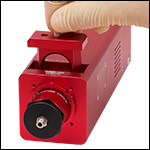
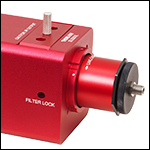
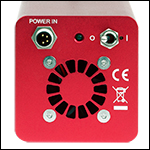
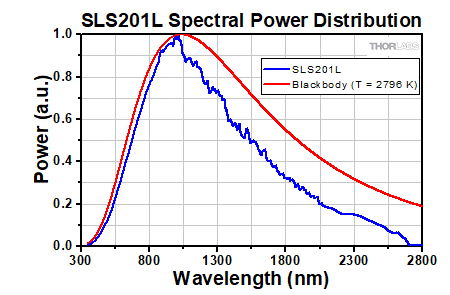
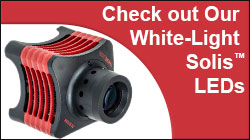
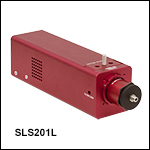
 Zoom
Zoom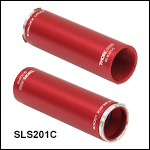
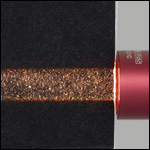


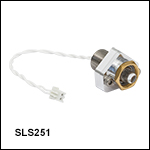
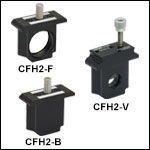
 Compact Stabilized Tungsten-Halogen Light Source
Compact Stabilized Tungsten-Halogen Light Source